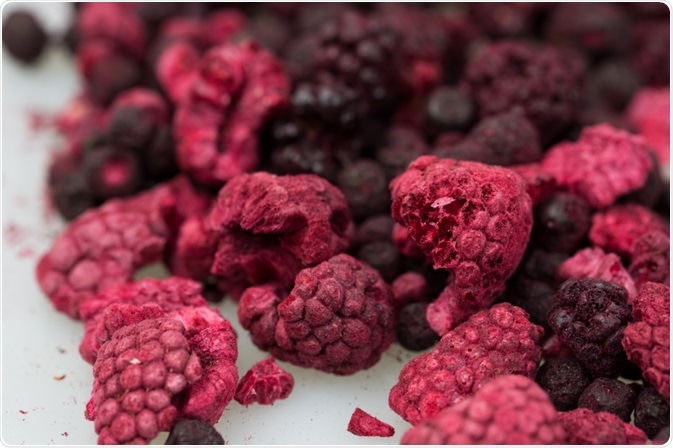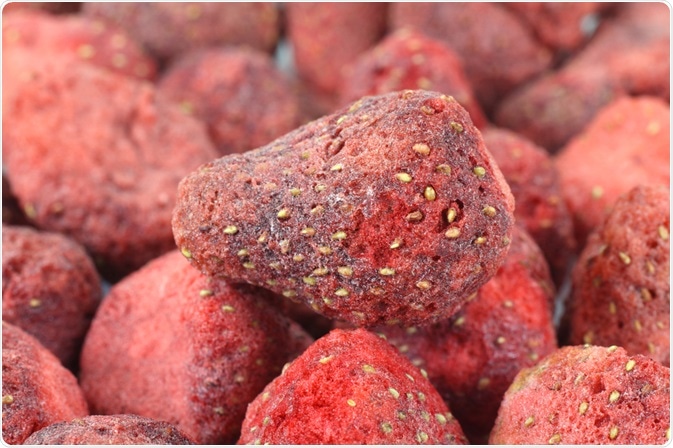Freeze-drying, also referred to as lyophilization, is a process that involves freezing a substance at very low temperatures and then extracting liquid via sublimation, converting water from a solid to gaseous state. A major advantage of this process is that the water extracted this way passes straight from solid to gas without going through the liquid phase.
Freeze-drying is very good at increasing the shelf-life and storage length of a product while retaining its three-dimensional shape and integrity. It is a commonly used preservation technique in the food industry, which is suitable for many different types of food. It produces a high-quality product.
Skip to:
 Image Credit: Vilsone / Shutterstock.com
Image Credit: Vilsone / Shutterstock.com
The Lypophilization Process
Lyophilization is performed in three main stages using specialist equipment. The process involves:
- Freezing – This is carried out rapidly to avoid the formation of large ice crystals, which can damage the structure of the product.
- Vacuum – The product is subjected to a deep vacuum, well below the triple point of water. This is the point where solid, liquid, and gaseous forms of the material can coexist.
- Drying – Water is drawn out of the material through sublimation, which causes the solid ice to transition to gaseous vapor without passing through the liquid phase again. Low pressure (to a few millibars) aids in this part of the process. Thus, the structural integrity and chemical profile of the product can be preserved to a high degree.
Food that is to undergo freeze-drying is typically pre-treated in some manner. Common methods include the concentration of the product, increasing the surface area, addition of components such as preservatives, and IQF (Individual Quick Freezing) of smaller pieces of food (this makes the food product free-flowing and better suited for the process.) Pre-treatment is usually carried out because of the demands of cycle time and considerations of product quality.
History of Lyophilization in the Food Industry
Lyophilization can be traced back to uses by indigenous populations in South America. Potatoes and other tubers that grew in the lowlands would be transported to high altitudes, pressed to remove the liquid and then preserved by the low temperatures at night. This created a long-lasting, storable food called chuño (a type of mash) which could be used as an emergency ration.
It was not until the 1890s that freeze-drying started to be developed into an industrialized process. Richard Altmann developed a process to freeze-dry plant and animal tissues, but the process went largely unnoticed until the late 1920s and into the 1930s.
It was at this time when Tival and Elser patented freeze-drying systems that improved upon the 1909 invention of the vacuum chamber by Shackell. Their work significantly improved the freezing and condensing steps. In the 1950s and 1960s, with shifting consumer needs, freeze-drying started to be used more widely in the food industry.
The early uses of lyophilization in the food industry were mainly for military rations and food developed for astronauts. The increased shelf-life made it suitable for the unique needs of both the military and NASA.
Developments in the process of rehydrating meals meant that hot meals could be provided. For astronauts, the early attempts produced “tube” meals and snacks that proved difficult to rehydrate. This was a significant improvement.
 Image Credit: BW Folsom / Shutterstock.com
Image Credit: BW Folsom / Shutterstock.com
Today, freeze-drying is used in a wide range of common food products, including freeze-dried instant coffee, ice cream, fruit and vegetables, meats and meat substitutes. The process is used to create high-quality food products with the nutrients “locked-in”.
Compared to air-drying, which is another common form of preservation that involves heat treating a product in air, no quality is lost in this process. Air-drying can lead to physical alteration including shrinkage and damage to the microscopic structure, biochemical effects, and chemical reactions.
Problems can also occur in food preservation when it comes to microbial infection and spoilage. Infective agents can still be present even at low temperatures, which is why food must be packaged and stored correctly to avoid the absorption of moisture.
The Future of Freeze-drying in the Food Industry
The food industry is a multi-billion dollar industry. As the tastes and economic considerations of consumers evolve, there is more need for high-quality nutritious food products that can be readily available in stores for purchase. As the world becomes more connected, the storage and transportation of food is becoming more of a consideration for governments and businesses.
Lyophilization is a tested and proven technology that meets the criteria and needs of an ever-evolving society. From strawberries to chicken, coffee, and tea, to ingredients for pastries and ready meals, lyophilization as a method of preservation likely has a long future ahead of it.
Further Reading